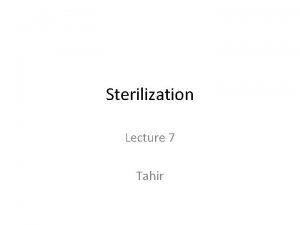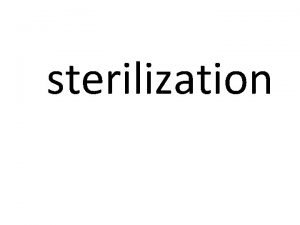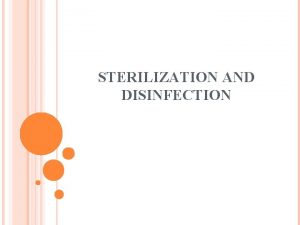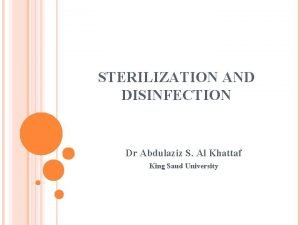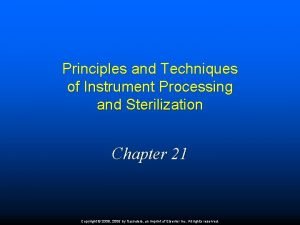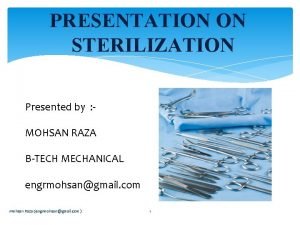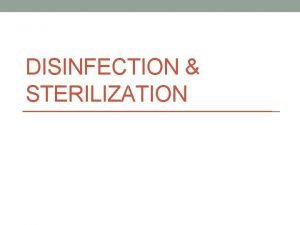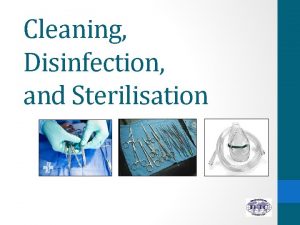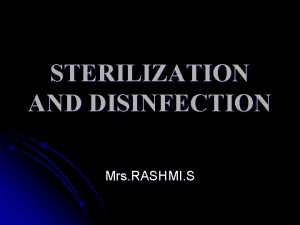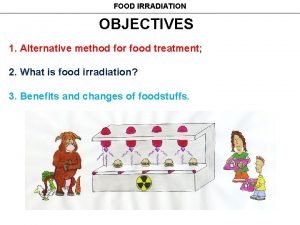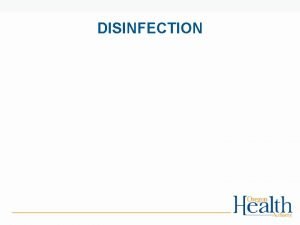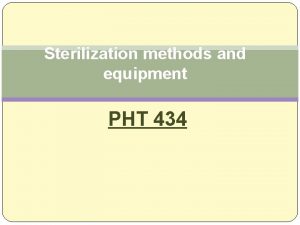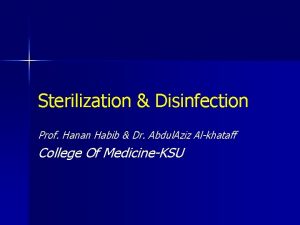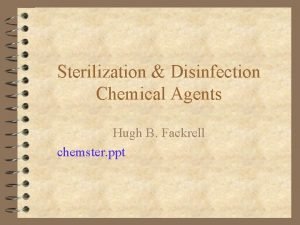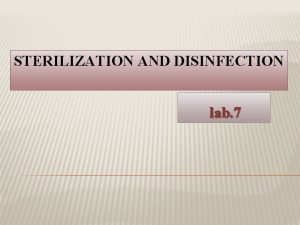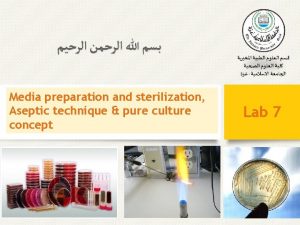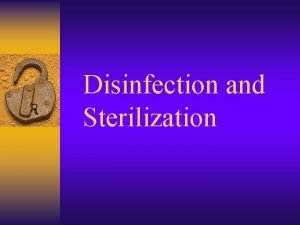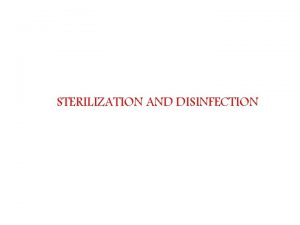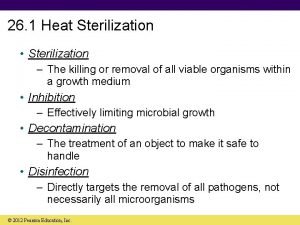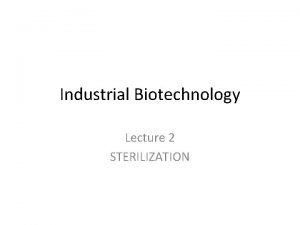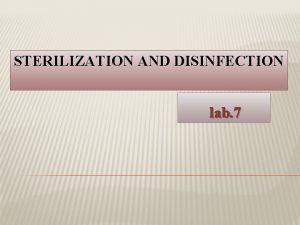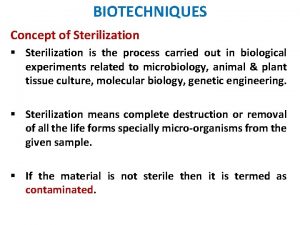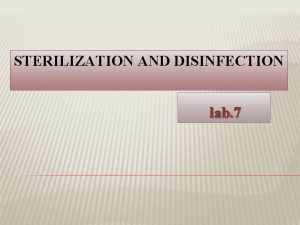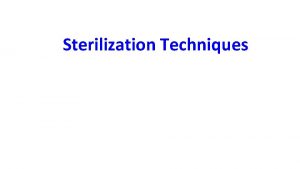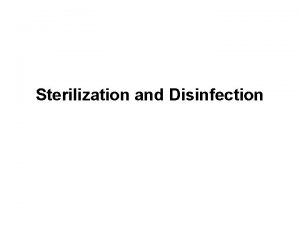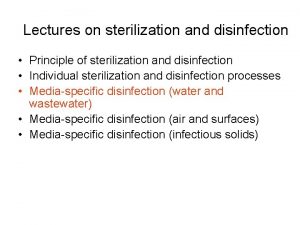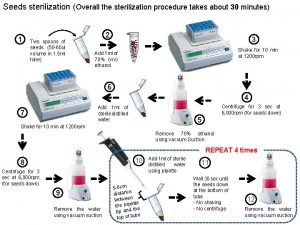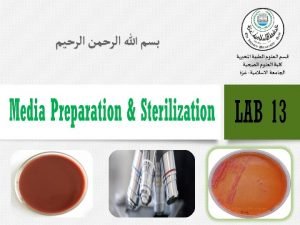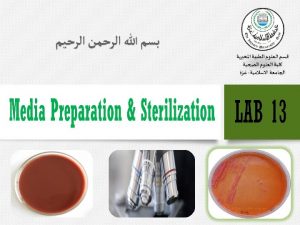Chapter 6 Sterilization Outline Introduction Medium sterilization The
















![Kinetics of Sterilization Rearranging the eqn [1] -d. N/N = kdt Upon Integration ln Kinetics of Sterilization Rearranging the eqn [1] -d. N/N = kdt Upon Integration ln](https://slidetodoc.com/presentation_image_h2/10a3e1e8751bcd9f3de1aaf941597191/image-17.jpg)























































- Slides: 72

Chapter 6 Sterilization

Outline • Introduction • Medium sterilization • The Design of Batch Sterilization process • The Design of Continuous Sterilization process • Filter sterilization (Air and Media)

Introduction: Definition • Is the action of eliminating microorganisms from a medium (Ghasem 2007) • Reduction of any naturally occurring organisms in the substrate and air supply to a level where they are unable to compete effectively for the nutrients in the substrate with the organism being deliberately cultivated (Jackson 1990) • Killing any microbes that is present in the media or passed through any filtering system (Layman)

Introduction: Definition • Sterilization: inactivation of all living organisms (both vegetative cells and spores) • Pasteurization: inactivation of all vegetative cells • Spores are more resistent to extreme conditions like high temperature, high pressure, low p. H, …

If the fermentation is contaminated 1. The medium would have to support the growth of both producer and contaminant organism resulting in loss of productivity. 2. In case of continuous cultivation the contaminant may outgrow the producer organism. 3. In case of biomass as product, the contaminant will result in total loss of product. 4. The contaminant may produce compounds, which make downstream processing difficult. 5. The contaminant may degrade the product; this is common in antibiotics fermentation eg. β Lactamase producing organism degrade β-Lactum antibiotics. 6. Contaminant with phage could result in the lysis of culture

Introduction • Avoidance of contamination may be achieved by – – – using a pure inoculum to start the fermentation sterilizing the medium sterilizing the fermentor sterilizing all feeds maintaining aseptic conditions during the fermentation

Introduction: Where is it being used? Food & dairy industries • Pharmaceutical industries • Research laboratories and etc. • • Autoclave → huge stainless steel vessel → steam → 105 k. Pa (15 psig) for 20 -30 mins • High temp & long duration → will kill microorganism / spores of fungus / bacteria • Overheating → negative impact / media components destroyed / media p. H ↓ / affected culture growth → acid p. H sensitive to heating → carbohydrates will caramelize → difficult to solidify

Introduction • Probability of contamination ? – Some fermentations are ‘protected’ against contamination • Medium utilized by a limited range of microorganisms • Growth may result in the development of selective growth conditions Example: ‘BREWING OF BEER’ – Water – Wort – Hop

Example: Brewing of beer • Hop resins tend to inhibit the growth of many micro-organisms → added to give bitter taste

Example: Brewing of beer • Growth of brewing yeasts tends to decrease p. H Glucose → ethanol + organic acid

Example: Brewing of beer Result: • Wort is boiled, not sterilized • Fermentor is cleaned but not sterile – Majority of fermentations is ‘not protected’ !!!

Medium Sterilization • Filtration • Radiation • Ultrasonic treatment • Chemical treatment • Heat

Radiations Many cellular materials absorb ultraviolet light, leading to DNA damage and consequently to cell death. Wavelengths around 265 nm have the highest bacterial efficiency. However they have very little ability to penetrate. Use is limited to clean chambers, operation theatre etc. , X-rays are lethal and have penetration ability. However due to expensive and safety concerns it is not used

Chemical sterilization Chemical agents are frequently used for disinfection. Major antimicrobial chemical agents are : - phenol and compounds - alcohol - Detergents, acids, and alkali

Kinetics of sterilization • Destruction of microorganisms by steam is represented by first order reaction -d. N/dt = k. N (1) N the total number of viable organisms present where t Time of sterilization treatment k Reaction constant of the reaction( specific death rate) - Dependent on the species - Dependent on the physiological form( vegetative cell, spore - Dependent on temperature(

Kinetics of sterilization • Destruction of microorganisms by steam is represented by first order reaction -d. N/dt = k. N Compare to growth kinetics: dx/dt = µx Expressed as cell concentration! (Chapter 5) (1)
![Kinetics of Sterilization Rearranging the eqn 1 d NN kdt Upon Integration ln Kinetics of Sterilization Rearranging the eqn [1] -d. N/N = kdt Upon Integration ln](https://slidetodoc.com/presentation_image_h2/10a3e1e8751bcd9f3de1aaf941597191/image-17.jpg)
Kinetics of Sterilization Rearranging the eqn [1] -d. N/N = kdt Upon Integration ln (Nt/No) = - kt (2) Nt/No = e-kt (3) Nt = No of organisms present after sterlization No = No of organisms present before sterlization

ln Time Nt/No = e-kt Time ln (Nt/No) = - kt • An infinite time is required to achieve sterile condition i. e. Nt=0 • After certain period there will be less than one viable cell present i. e Nt<1

• Nt<1 is the probability of an organism surviving the treatment • i. e. Nt=0. 1 is the probability that one organism surviving ten treatments. • In other words one in ten batches may get contaminated due to improper sterlization • The value of k is dependent on temperature, species and its physiological form. • But your sterlization media contains mixture of microorganism.

E. coli B. stereothermophillus

As in any first order, The reaction rate increases with increase in temperature i. e. k increases with increase in temperature. This relation ship is given by Arrhenius eqn. (4) E R T A activation energy gas constant absolute temperature Arrhenius constant

Taking logarithm of eqn 4 (5) Plot of ln k Vs 1/T will give a straight line( Arrhenius plot) Such a plot is termed an Arrhenius plot and enables the calculation of the activation energy and the prediction of the reaction rate for any temperature Intercept = ln A Slope = -E/R Ln k 1/T

Design criterion • The design criterion ( ∇ ) for sterilization which is a measure of the destruction ratio can be defined as: • It is a parameter which encompasses the contamination level of the medium to be sterilized, No, and the desired sterility level, Nt.

Design criterion • Also known as the Del factor, a measure of the size of the job to be accomplished. For example, the Del factor to reduce the number of cells in a fermenter from 1010 viable organisms to one is : • The Del factor to reduce the number of cells to zero is infinity, which means that it is theoretically impossible to ensure the total destruction of the viable cells. • Industrially accepted level of contamination is 0. 001. i. e. 1 in 1000 batches can get contaminated

Combining eqn 2 and 4 (6) Del factor is the sterilization criterion (7) (8)

Example 1

Step 1 Plot ln No/Nt Vs Time for each temperature and find out the slope. Slope will give k value. Step 2 Plot ln k Vs 1/T from the above values. Slope will give E/R values and Intercept will give you the A value Step 3 From the above graph calculate the k value for 100 o. C Step 4 From the k value calculate time required to kill 99% spores

Y=0. 0326 X Y=0. 0122 X

Y=9. 5859 X Y=1. 5943 X

1/T Ln k

E/R = 26869 o. K R = 8. 3144 J/K/gmol E = 26869 X 8. 3144 = 2. 24 X 105 J/gmol=224 KJ/gmol A =4. 7 X 1030 min-1 k= 4. 7 X 1030 e-26869/T T=100 +273 =373 o. K k=0. 244 min-1 Ln(100/1)=0. 244 t t=18. 9 min

Batch sterilization • The medium is prepared and pumped to an agitated vessel fitted with either a heating jacket or heating coils. • The contents of the vessel are then heated to a particular sterilization temperature (usually 121 o. C, held for a certain length of time at that temperature, and then cooled down to the fermentation temperature. • This time of process is carried out in the fermentor itself – in-situ sterilization

Batch Sterilization • Sterilization of the medium in a fermenter can be carried out in batch mode by direct steam sparging, by electrical heaters, or by circulating constant pressure condensing steam through heating coil.

Temperature (o. C) sterilization cooling heating Time (min)

Holdup Temperature Heating Time Cooling


Temperature Heating Curve T 3 T 2 T 1 t 2 t 3 Time

Example 2 The initial concentration of contaminants is 106 per ml and the fermenter volume is 10000 liters. The del factor contribution from heating is 9. 8 and that of cooling is 10. 1. Calculate the holdup time assuming all the contaminants are B. st having k value at 121 o. C of 2. 54 min-1

No = 106 X 10000 =1013 Nt=0. 001

Design of batch sterilization process • Scale up of batch sterilization processes – Example: calculate Del factor for • 1000 l medium containing 106 micro-organims/ml and Nt = 1/1000 V = In {(10 X l 0 )/10 } 6 3 3 -3 = In (1012/10 -3) = In 1015 = 34. 5. • 10 000 l medium containing 106 micro-organims/ml V = In {(10 X 10 )/l 0 } and Nt = 1/1000 6 3 4 = In (1013/10 -3) ~ In 1016 = 36. 8. Del factor increases with an increase in the medium volume -3


Theoretical equations for heating and cooling can be employed, which are of linear, exponential, or hyperbolic form depending on the mode of heating and cooling. The suggested equations for different heating and cooling processes are as follows: a. For batch heating by direct steam sparging into the medium, the hyperbolic form is used:

b. For batch heating with a constant rate of heat flow such as electrical heating, the linear form is used: c. For batch heating with a isothermal heat source such as steam circulation through heating coil, the exponential form is used: d. For batch cooling using a continuous non isothermal heat sink such as passing cooling water through cooling coil, the exponential form is used:


Due to sterilization deleterious reactions may occur resulting in loss of nutrient quality The initial rise in yield is due to some components of the medium being made more available to the process micro-organism by the 'cooking effect' of a brief sterilization period. Product yield The fermentation media is not an inert mixture. Duration of sterilization

Loss of nutrient quality is due to two reasons i) Interactions between nutrient components of the medium Maillard type browning reaction – reactions of the carbonyl group usually from reducing sugar with the amino group of aminoacids, proteins. n Effect of sterilization time on availability of glucose in CSL medium was investigated n Time 60 min 40 min 30 min Glucose remaining 35% 46% 64% Problems of this type are normally resolved by sterilizing sugar separately and adding to the medium

Degradation of heat labile components II. n Certain vitamins, amino acids and proteins may be degraded during sterilization regime In certain cases such as animal cell culture media filtration is used In other cases judicious choice of sterilization regime is selected. Nutrient destruction follows first order reaction Xt is the concentration of nutrient after a heat treatment period, t, X 0 is the original concentration of nutrient at the onset of sterilization, k is the reaction rate constant.

The effect of temperature on the reaction rate constant may be expressed by the Arrhenius equation: Therefore, a plot of the natural logarithm of the reaction rate against 1/T will give a straight line, slope - (E / R). As the value of R, the gas constant, is fixed the slope of the graph is determined by the value of the activation energy (E)

Figure 5. 6 is an Arrhenius plot for two reactions - one with a lower activation energy than the other. From this plot it may be seen that as temperature is increased, the reaction rate rises more rapidly for the reaction with the higher activation energy.

Heating the huge reactors for higher temperature and cooling down in short duration is impossible Alternately continuous sterilizer can be used Ln k From the graph it is evident that sterilizing the medium at higher temperature for lesser time will result in spores destruction with lesser loss in nutrient quality. Spores destruction Nutrient destruction 1/T

The Design of continuous sterilization Advantage - a much higher temperature may be utilized, reducing holding time and nutrient degradation Typical time- temperature combination for continuous sterilization

The Design of continuous sterilization Advantage - a much higher temperature may be utilized, reducing holding time and nutrient degradation - ‘heating up’ and ‘cooling down’ periods are very small – nearly negligible


Design of continuous sterilization process Advantage - a much higher temperature may be utilized, reducing holding time and nutrient degradation - ‘heating up’ and ‘cooling down’ periods are very small – nearly negligible • Heating: two sequential continuous heat exchangers • Holding: holding coil with holding time proportional to coil length • Cooling: two sequential continuous heat exchanger


Types of continuous sterilizers • Indirect heat exchanger – plate heat exchanger • Direct heat exchanger – steam injector

consist of alternating plates through which the countercurrent streams are circulated The plates are separated by gaskets and failure of these gaskets can cause crosscontamination between the two streams

Plate heat exchanger

The continuous steam injector injects steam directly into the unsterile broth







Filter sterilization • Suspended solids may be separated from a fluid during sterilization by the following mechanisms - Inertial impaction - Diffusion - Electrostatic attraction - Interception

Inertial impaction • The inertial impaction model assumes particles has mass, and hence inertia, but no size. . • Due to this they tend to move straight and therefore impact on the filtration fibers where they may be retained. • This mechanism is more prominent in filtration of gases than liquids.

Diffusion • Extremely small particles suspended in the fluid are subjected to Brownian movement which is random movement due to collision of particles. • Thus due to this the fluid particles deviate from the path of movement and impact on the filter fibers. • Diffusion is more significant in the filtration of gases than liquids

Electrostatic attraction • Charged particles are attracted by opposite charges on the surface of the filtration medium

Interception • The inertial impaction model assumed particles had mass, and hence inertia, but no size. • An interception mechanism is considered where the particle has size, but no mass, and so they can follow the streamlines of the air around the collector • If a streamline which they are following passes close enough to the surface of the fiber, the particles will contact the fiber and be removed shown in the figure

Types of filters • ‘Fixed pore’ filter membrane filter • ‘Non-fixed pore’ filter depth filter 77

Filter sterilization • for fermentation media with heat-labile components (membrane filtration) • for incoming air and exhaust air (heat sterilization is not practical) (membrane filtration or depth filters) 79
 Hot and cold definition
Hot and cold definition Medium medium 35m newton
Medium medium 35m newton Sentence outline examples
Sentence outline examples Hình ảnh bộ gõ cơ thể búng tay
Hình ảnh bộ gõ cơ thể búng tay Ng-html
Ng-html Bổ thể
Bổ thể Tỉ lệ cơ thể trẻ em
Tỉ lệ cơ thể trẻ em Gấu đi như thế nào
Gấu đi như thế nào Tư thế worm breton là gì
Tư thế worm breton là gì Hát lên người ơi
Hát lên người ơi Môn thể thao bắt đầu bằng từ đua
Môn thể thao bắt đầu bằng từ đua Thế nào là hệ số cao nhất
Thế nào là hệ số cao nhất Các châu lục và đại dương trên thế giới
Các châu lục và đại dương trên thế giới Công thức tính độ biến thiên đông lượng
Công thức tính độ biến thiên đông lượng Trời xanh đây là của chúng ta thể thơ
Trời xanh đây là của chúng ta thể thơ Cách giải mật thư tọa độ
Cách giải mật thư tọa độ 101012 bằng
101012 bằng Phản ứng thế ankan
Phản ứng thế ankan Các châu lục và đại dương trên thế giới
Các châu lục và đại dương trên thế giới Thơ thất ngôn tứ tuyệt đường luật
Thơ thất ngôn tứ tuyệt đường luật Quá trình desamine hóa có thể tạo ra
Quá trình desamine hóa có thể tạo ra Một số thể thơ truyền thống
Một số thể thơ truyền thống Cái miệng xinh xinh thế chỉ nói điều hay thôi
Cái miệng xinh xinh thế chỉ nói điều hay thôi Vẽ hình chiếu vuông góc của vật thể sau
Vẽ hình chiếu vuông góc của vật thể sau Thế nào là sự mỏi cơ
Thế nào là sự mỏi cơ đặc điểm cơ thể của người tối cổ
đặc điểm cơ thể của người tối cổ Thế nào là giọng cùng tên
Thế nào là giọng cùng tên Vẽ hình chiếu đứng bằng cạnh của vật thể
Vẽ hình chiếu đứng bằng cạnh của vật thể Tia chieu sa te
Tia chieu sa te Thẻ vin
Thẻ vin đại từ thay thế
đại từ thay thế điện thế nghỉ
điện thế nghỉ Tư thế ngồi viết
Tư thế ngồi viết Diễn thế sinh thái là
Diễn thế sinh thái là Dot
Dot Thế nào là số nguyên tố
Thế nào là số nguyên tố Tư thế ngồi viết
Tư thế ngồi viết Lời thề hippocrates
Lời thề hippocrates Thiếu nhi thế giới liên hoan
Thiếu nhi thế giới liên hoan ưu thế lai là gì
ưu thế lai là gì Sự nuôi và dạy con của hổ
Sự nuôi và dạy con của hổ Khi nào hổ mẹ dạy hổ con săn mồi
Khi nào hổ mẹ dạy hổ con săn mồi Hệ hô hấp
Hệ hô hấp Từ ngữ thể hiện lòng nhân hậu
Từ ngữ thể hiện lòng nhân hậu Thế nào là mạng điện lắp đặt kiểu nổi
Thế nào là mạng điện lắp đặt kiểu nổi Introduction paragraph outline
Introduction paragraph outline 5 paragraph essay outline
5 paragraph essay outline Software engineering 1 course outline
Software engineering 1 course outline Hot air sterilizer diagram
Hot air sterilizer diagram Advantages of continuous sterilization
Advantages of continuous sterilization Asbetose
Asbetose Classification of sterilization
Classification of sterilization Beta-propiolactone sterilization
Beta-propiolactone sterilization Sterilization
Sterilization Principle of autoclave ppt
Principle of autoclave ppt Methods of instrument processing
Methods of instrument processing Define sterilization slideshare
Define sterilization slideshare Sterilization
Sterilization Beery twins
Beery twins Forced sterilization
Forced sterilization Sterilization quality control
Sterilization quality control Low level disinfectant
Low level disinfectant Beta propiolactone
Beta propiolactone Heat preservation
Heat preservation Gamma irradiation sterilization process
Gamma irradiation sterilization process What is sterilization
What is sterilization Package sterilization
Package sterilization Mechanical sterilization
Mechanical sterilization Sterilization and disinfection
Sterilization and disinfection Sterilization and disinfection
Sterilization and disinfection Sterilization and disinfection
Sterilization and disinfection Nurses responsibility in sterilization
Nurses responsibility in sterilization Principle of sterilization
Principle of sterilization

















































